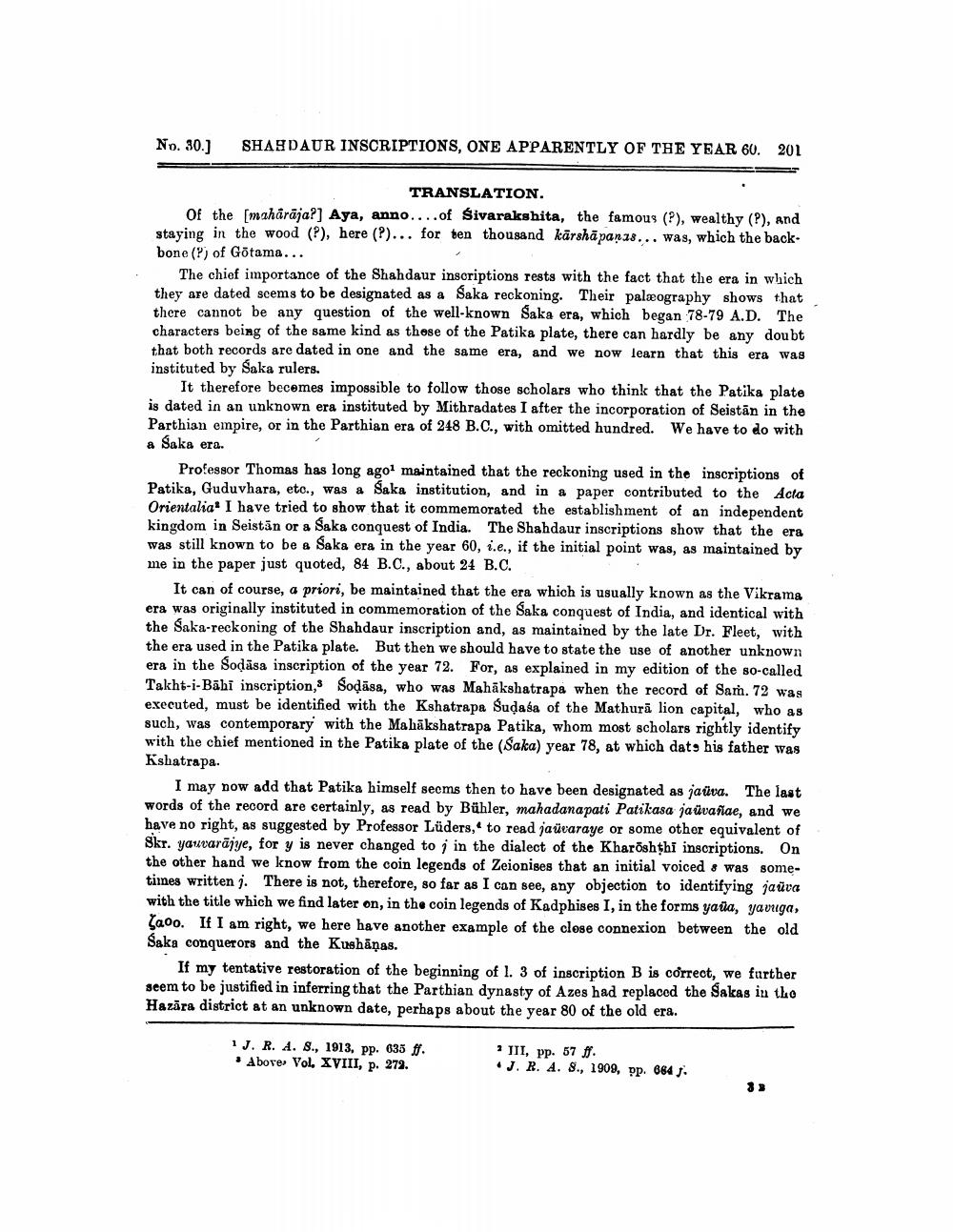________________
No. 30.]
SHAHDAUR INSCRIPTIONS, ONE APPARENTLY OF THE YEAR 60. 201
TRANSLATION.
Of the [maharaja?] Aya, anno....of Sivarakshita, the famous (?), wealthy (?), and staying in the wood (?), here (?)... for ten thousand kārshapanas... was, which the backbone (P) of Götama...
The chief importance of the Shahdaur inscriptions rests with the fact that the era in which they are dated seems to be designated as a Saka reckoning. Their palæography shows that there cannot be any question of the well-known Saka era, which began 78-79 A.D. The characters being of the same kind as these of the Patika plate, there can hardly be any doubt that both records are dated in one and the same era, and we now learn that this era was instituted by Saka rulers.
It therefore becomes impossible to follow those scholars who think that the Patika plate is dated in an unknown era instituted by Mithradates I after the incorporation of Seistan in the Parthian empire, or in the Parthian era of 248 B.C., with omitted hundred. We have to do with a Saka era.
Professor Thomas has long ago1 maintained that the reckoning used in the inscriptions of Patika, Guduvhara, etc., was a Saka institution, and in a paper contributed to the Acta Orientalia I have tried to show that it commemorated the establishment of an independent kingdom in Seistän or a Saka conquest of India. The Shahdaur inscriptions show that the era was still known to be a Saka era in the year 60, i.e., if the initial point was, as maintained by me in the paper just quoted, 84 B.C., about 24 B.C.
It can of course, a priori, be maintained that the era which is usually known as the Vikrama era was originally instituted in commemoration of the Saka conquest of India, and identical with the Saka-reckoning of the Shahdaur inscription and, as maintained by the late Dr. Fleet, with the era used in the Patika plate. But then we should have to state the use of another unknown era in the Soḍāsa inscription of the year 72. For, as explained in my edition of the so-called Takht-i-Bahi inscription,s Soḍāsa, who was Mahakshatrapa when the record of Sam. 72 was executed, must be identified with the Kshatrapa Suḍaśa of the Mathura lion capital, who as such, was contemporary with the Mahakshatrapa Patika, whom most scholars rightly identify with the chief mentioned in the Patika plate of the (Saka) year 78, at which dats his father was Kshatrapa.
I may now add that Patika himself seems then to have been designated as jaüva. The last words of the record are certainly, as read by Bühler, mahadanapati Patikasa jaüvañae, and we have no right, as suggested by Professor Lüders, to read jaüvaraye or some other equivalent of Skr. yauvarajye, for y is never changed to j in the dialect of the Kharoshthi inscriptions. On the other hand we know from the coin legends of Zeionises that an initial voiced & was sometimes written j. There is not, therefore, so far as I can see, any objection to identifying java with the title which we find later on, in the coin legends of Kadphises I, in the forms yaua, yavuga, Laoo. If I am right, we here have another example of the close connexion between the old Saka conquerors and the Kushanas.
If my tentative restoration of the beginning of 1. 3 of inscription B is correct, we further seem to be justified in inferring that the Parthian dynasty of Azes had replaced the Sakas in the Hazara district at an unknown date, perhaps about the year 80 of the old era.
1 J. R. A. 8., 1913, pp. 635 ff. Above Vol. XVIII, p. 272.
2 III, pp. 57 ff.
J. R. A. S., 1909, pp. 664 J.
33




